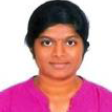
Pranaya Pasula
Work place: Department of ECE, Rajiv Gandhi University of Knowledge and Technologies, Basar, Telangana, 504107, India
E-mail: pranaya@rgukt.ac.in
Website: https://orcid.org/0009-0006-9639-499X
Research Interests:
Biography
Pranaya Pasula is currently serving as an Assistant Professor in the Department of Electronics and Communication Engineering (ECE) at Rajiv Gandhi University of Knowledge and Technologies, Basar. She obtained her M. Tech degree in VLSI from Jawaharlal Nehru Technological University (JNTU) Hyderabad, following her undergraduate studies in Electronics and Communications Engineering (ECE) from the same institution. Her research interests lie in the interdisciplinary fields of VLSI, Advanced Microcontrollers-Embedded Systems and Machine Learning.
Author Articles
Performance Analysis of Optimal and Hybrid Beamforming Techniques and Spectral Efficiency Enhancement for 5G Millimeter-Wave Systems
By Padmasree Ramineni Pranaya Pasula Tejasvey Panchareddy
DOI: https://doi.org/10.5815/ijwmt.2025.01.04, Pub. Date: 8 Feb. 2025
Millimeter-wave (mm-wave) communication stands as a vital technology for future wireless networks, necessitating efficient beamforming techniques to mitigate significant path loss and harness the extensive mm-wave spectrum. Traditional fully digital beamforming methods are often deemed unfeasible due to the substantial costs and energy requirements, which stem from the need for individual radio frequency (RF) chains for each antenna element particularly in Massive MIMO systems. Hybrid beamforming emerges as a more economical solution, reducing both hardware expenses and energy consumption by utilizing a limited number of RF chains. This paper offers an in-depth evaluation of hybrid beamforming in 5G and beyond mm-wave systems, proposing a new classification framework for various hardware configurations. The research employs a practical approach to compare different strategies, focusing on two main factors: the beam patterns produced with optimal and hybrid weights, and the resulting spectral efficiency, which is a key performance metric. The findings indicate that the beam patterns generated with both optimal and hybrid weights display comparable characteristics, especially for dominant beams. Additionally, the study shows that increasing the number of data streams leads to a significant boost in spectral efficiency, an essential element for enhancing 5G network performance. The systematic comparisons delve into the interactions and trade-offs between these design aspects, highlighting promising candidates for hybrid beamforming in the wireless communication systems of the future.
[...] Read more.Other Articles
Subscribe to receive issue release notifications and newsletters from MECS Press journals